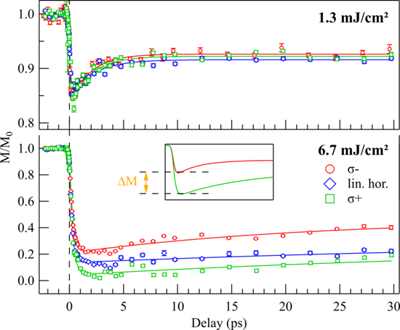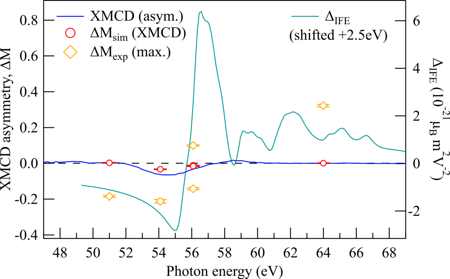From Max Born Institute, Controlling Magnetism with Polarized Light
Intense laser pulses can be used to manipulate or even switch the magnetization orientation of material on extremely short time scales.
This is a Press Release edited by StorageNewsletter.com on July 17, 2024 at 2:18 pmFrom Max Born Institute
Intense laser pulses can be used to manipulate or even switch the magnetization orientation of a material on extremely short time scales.
Typically, such effects are thermally induced, as the absorbed laser energy heats up the material very rapidly, causing an ultrafast perturbation of the magnetic order. Scientists from the Max Born Institute (MBI), in collaboration with an international team of researchers, have now demonstrated an effective non-thermal approach of generating large magnetization changes.
By exposing a ferrimagnetic iron-gadolinium alloy to circularly polarized pulses of extreme ultraviolet (XUV) radiation, they could reveal a particularly strong magnetic response depending on the handedness of the incoming XUV light burst (left- or right-circular polarization). The underlying mechanism is based on the inverse Faraday effect, which does not rely on the absorption of the light, but provides an efficient interaction between its polarization and the magnetic moments in the material. The study has now been published in Communications Physics.
When an intense laser pulse hits a magnetized medium, its impact on the magnetization can usually be attributed to the amount of energy introduced into the material when it is absorbed. Microscopically, this corresponds to an optical excitation of electrons, which are rapidly brought into non-equilibrium and start to scatter with each other and other quasiparticles, changing the electron spin and orbital moments and therefore the long-range magnetization. Although such mechanisms give rise to a variety of fascinating phenomena, including ultrafast demagnetization and laser-induced magnetization switching, they come at the price of a substantial heat load on the material, limiting technological applicability where fast repetition rates are required, e.g., for RW-operations in future storage technologies.
An international team of researchers, led by scientists from MBI, has now studied an entirely different, non-thermal pathway of manipulating magnetism by light. Their approach is based on an opto-magnetic phenomenon that does not rely on electronic heating induced by the absorption of the light, but rather on a direct, coherent interaction between the light’s polarization and the electronic spins. The underlying mechanism is the inverse Faraday effect (IFE), which leads to the generation of magnetic moments in a medium optically excited by circularly polarized radiation, with the direction of the magnetization depending on the left- or right-handedness of the circular polarization, i.e., its helicity. However, as the metallic and highly absorptive properties of most ferro- and antiferromagnetic materials typically suppress the aforementioned non-thermal effects, a special technique had to be developed to generate a sizeable opto-magnetic response: Using circularly polarized femtosecond pulses of extreme ultraviolet (XUV) radiation, generated at the free-electron laser FERMI, the scientists could demonstrate the generation of a particularly strong IFE-induced magnetization in a metallic, ferrimagnetic iron-gadolinium (FeGd) alloy. This is possible because of the high photon energy of the XUV radiation, allowing resonant excitation of tightly bound core-level electrons, which due to their intrinsic properties (in particular, a strong spin-orbit coupling) facilitate the generation of large opto-magnetic effects.
Fig. 1: Magnetization dynamics induced by femtosecond XUV pulses tuned to the Fe M3,2 resonance (54.1 eV) of FeGd with variable polarization (circular polarization with opposite helicities σ± and linear horizontal polarization) for two different excitation fluences. The helicity-dependent effect ΔM corresponds to the IFE-induced difference of the demagnetization amplitudes for σ±-excitation.
With this approach, the scientists could show that, for different XUV photon energies around the Fe M3,2 core-level resonance, the IFE-induced magnetization can reach up to 20-30% of the ground-state magnetization of the alloy, measured by the difference between the ultrafast demagnetization induced for opposite helicities of the circularly polarized XUV pulses (Fig. 1).
Fig. 2: Comparison of the largest experimentally observed helicity-dependent effects ΔMexp (yellow diamonds, left scale) to the calculated IFE response ΔIFE (turquoise line, right scale) as a function of XUV photon energy. ΔMsim (red diamonds, left scale) shows the expected influence of the XMCD (blue line) on the magnetization dynamics, which is too small to explain the observed effects.
Supported by ab initio theory and spin dynamics simulations, it could also be demonstrated that the observed effects are in line with the expected IFE response (Fig. 2) and cannot be explained by a purely thermal helicity-dependent mechanism, such as the well-established x-ray magnetic circular dichroism (XMCD). Providing an efficient method for the non-thermal generation of large magnetization on ultrafast time scales, these findings are expected to be of high relevance for the fields of ultrafast magnetism and spintronics, as well as coherent magnetization control and the science of nonlinear x-ray matter interactions.
Article: Ultrafast opto-magnetic effects in the extreme ultraviolet spectral range
Communications Physics has published an article written by Martin Hennecke, Clemens von Korff Schmising, Kelvin Yao, Max-Born-Institut für Nichtlineare Optik und Kurzzeitspektroskopie, Max-Born-Straße 2A, 12489, Berlin, Germany, Emmanuelle Jal, Boris Vodungbo,Valentin Chardonnet, Sorbonne Université, CNRS, Laboratoire de Chimie Physique ‒ Matière et Rayonnement, LCPMR, 75005, Paris, France, Katherine Légaré, Institut National de la Recherche Scientifique, INRS-EMT, Varennes, QC, J3X 1P7, Canada, Flavio Capotondi, Denys Naumenko, Emanuele Pedersoli, FERMI, Elettra-Sincrotrone Trieste, 34149, Basovizza, Trieste, Italy, Ignacio Lopez-Quintas, FERMI, Elettra-Sincrotrone Trieste, 34149, Basovizza, Trieste, Italy, and Grupo de Investigación en Aplicaciones del Láser y Fotónica, Departamento de Física Aplicada, University of Salamanca, 37008, Salamanca, Spain, Ivaylo P. Nikolov, Lorenzo Raimondi, FERMI, Elettra-Sincrotrone Trieste, 34149, Basovizza, Trieste, Italy, Giovanni De Ninno, FERMI, Elettra-Sincrotrone Trieste, 34149, Basovizza, Trieste, Italy, and Laboratory of Quantum Optics, University of Nova Gorica, 5001, Nova Gorica, Slovenia, Leandro Salemi, Department of Physics and Astronomy, Uppsala University, P.O. Box 516, SE-751 20, Uppsala, Sweden, Sergiu Ruta, Department of Physics, University of York, York, YO10 5DD, UK, and College of Business, Technology and Engineering, Sheffield Hallam University, Howard Street, Sheffield, S1 1WB, UK, Roy Chantrell, Department of Physics, University of York, York, YO10 5DD, UK, Thomas Ostler, Department of Physics and Mathematics, University of Hull, Cottingham Road, Hull, HU6 7RX, UK, Bastian Pfau, Dieter Engel, Max-Born-Institut für Nichtlineare Optik und Kurzzeitspektroskopie, Max-Born-Straße 2A, 12489, Berlin, Germany, Peter M. Oppeneer, Department of Physics and Astronomy, Uppsala University, P.O. Box 516, SE-751 20, Uppsala, Sweden, Stefan Eisebitt, Max-Born-Institut für Nichtlineare Optik und Kurzzeitspektroskopie, Max-Born-Straße 2A, 12489, Berlin, Germany, and Institut für Optik und Atomare Physik, Technische Universität Berlin, Straße des 17. Juni 135, 10623, Berlin, Germany, and Ilie Radu, Max-Born-Institut für Nichtlineare Optik und Kurzzeitspektroskopie, Max-Born-Straße 2A, 12489, Berlin, Germany, and European X-ray Free-Electron Laser, Holzkoppel 4, 22869, Schenefeld, Germany.
Abstract: “Coherent light-matter interactions mediated by opto-magnetic phenomena like the inverse Faraday effect (IFE) are expected to provide a non-thermal pathway for ultrafast manipulation of magnetism on timescales as short as the excitation pulse itself. As the IFE scales with the spin-orbit coupling strength of the involved electronic states, photo-exciting the strongly spin-orbit coupled core-level electrons in magnetic materials appears as an appealing method to transiently generate large opto-magnetic moments. Here, we investigate this scenario in a ferrimagnetic GdFeCo alloy by using intense and circularly polarized pulses of extreme ultraviolet radiation. Our results reveal ultrafast and strong helicity-dependent magnetic effects which are in line with the characteristic fingerprints of an IFE, corroborated by ab initio opto-magnetic IFE theory and atomistic spin dynamics simulations.“















 Subscribe to our free daily newsletter
Subscribe to our free daily newsletter

